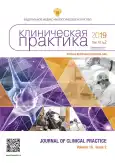Characteristics of sleep disorders in patients with chronic back pain
- Authors: Vinogradov D.K.1, Doronina O.B.1
-
Affiliations:
- Novosibirsk State Medical University
- Issue: Vol 10, No 2 (2019)
- Pages: 46-52
- Section: Original Study Articles
- URL: https://journals.rcsi.science/clinpractice/article/view/14522
- DOI: https://doi.org/10.17816/clinpract10246-52
- ID: 14522
Cite item
Full Text
Abstract
Background. Insomnia is considered a risk factor for the frequency of pain, however, no reliable studies with a comprehensive analysis of the objective polysomnography data have been conducted so far.
Objective. Using the method of polysomnography, to assess the changes in the structure of sleep in the chronic pain syndrome, by the example of chronic back pain.
Methods. The study was carried out in two groups (basic and control,) in which the patients were examined according to the following algorithm: an objective examination, assessment of the neurological status, filling in neurological scales and questionnaires, a single comprehensive study of the night sleep (polysomnography).
Results. According to the data of the polysomnographic study, presomnic disorders were detected in 25% of patients, intrasomnic disorders in 48%, and postsomnic disorders in 17%.
Conclusion. These sleep patterns, measured by polysomnography, demonstrate a link between sleep disorders, changes in the psycho-vegetative status, and chronic pain syndrome.
Keywords
Full Text
##article.viewOnOriginalSite##About the authors
Daniil K. Vinogradov
Novosibirsk State Medical University
Author for correspondence.
Email: webkraz@gmail.com
ORCID iD: 0000-0001-9303-1970
Postgraduate Student, Department of Neurology
Russian Federation, NovosibirskO. B. Doronina
Novosibirsk State Medical University
Email: doronina_ob@mail.ru
ORCID iD: 0000-0002-5136-7430
канд. мед. наук, доцент кафедры неврологии лечебного факультета
Russian Federation, NovosibirskReferences
- de Tommaso M, Delussi M, Vecchio E, et al. Sleep features and central sensitization symptoms in primary headache patients. J Headache Pain. 2014 6;15:64. doi: 10.1186/1129-2377-15-64.
- Baldwin CM, Ervin AM, Mays MZ, et al. Sleep disturbances, quality of life, and ethnicity: the Sleep Heart Health Study. J Clin Sleep Med. 2010;6(2):176-183.
- Thase ME. Treatment issues related to sleep and depression. J Clin Psychiatry. 2000;61 Suppl 11:46-50.
- Дубницкая Э.Б. Атипичные депрессии и гипомании. В кн.: Пограничная психическая патология в общемедицинской практике. / Под ред. А.Б. Смулевича. — М.: Издательский дом «Русский врач», 2000. — С. 15-18. [Dubnitskaya EB. Atipichnye depressii i gipomanii. In: Pogranichnaya psikhicheskaya patologiya v obshchemeditsinskoj praktike. Ed by A.B. Smulevich. Moscow: Izdatel'skij dom «Russkij vrach»; 2000. Р. 15-18. (In Russ).
- Fernandez-Mendoza J, Vgontzas AN, Liao D, et al. Insomnia with objective short sleep duration and incident hypertension: the Penn State Cohort. Hypertension. 2012;60(4):929-935. doi: 10.1161/HYPERTENSIONA-HA.112.193268.
- Bathgate CJ, Edinger JD, Wyatt JK, Krystal AD. Objective but not subjective short sleep duration associated with increased risk for hypertension in individuals with insomnia. Sleep. 2016;39(5):1037-1045. doi: 10.5665/sleep.5748.
- Engstrøm M, Hagen K, Bjørk MH, et al. Sleep quality and arousal in migraine and tension-type headache: the headache-sleep study. Acta Neurol Scand Suppl. 2014;(198):47-54. doi: 10.1111/ane.12237.
- Rains JC, Davis RE, Smitherman TA. Tension-type headache and sleep. Curr Neurol Neurosci Rep. 2015;15(2):520. doi: 10.1007/s11910-014-0520-2.
- Kikuchi H, Yoshiuchi K, Yamamoto Y, et al. Does sleep aggravate tension-type headache? An investigation using computerized ecological momentary assessment and actigraphy. Biopsychosoc Med. 2011;5:10. doi: 10.1186/1751-0759-5-10.
- Uhlig BL, Engstrøm M, Ødegård SS, et al. Headache and insomnia in population-based epidemiological studies. Cephalalgia. 2014;34(10):745-751. doi: 10.1177/0333102414540058.
- Дубинина Т.В., Елисеев М.С. Боль в нижней части спины: распространенность, причины, диагностика, лечение // Неврология, нейропсихиатрия, психосоматика. — 2011. — №1. — С. 22-26. [Dubinina TV, Eliseyev MS. Low back pain: prevalence, causes, diagnosis, treatment. Neurology, neuropsychiatry, psychosomatics. 2011;(1):22-26. (In Russ).]
- Caspersen N, Hirsvang JR, Kroell L, et al. Is there a relation between tension-type headache, temporomandibular disorders and sleep? Pain Res Treat. 2013;2013:845684. doi: 10.1155/2013/845684.
- Zhu Z, Fan X, Li X, et al. Prevalence and predictive factors for poor sleep quality among migraineurs in a tertiary hospital headache clinic. Acta Neurologica Belgica. 2013;113(3):229-235. doi: 10.1007/s13760-012-0159-1.
- Ковров Г.В., Лебедев М.А., Палатов С.Ю., и др. Нарушения сна при тревожных и тревожно-депрессивных расстройствах // РМЖ «Медицинское обозрение». — 2015. — №10. — С. 530. [Kovrov GV, Lebedev MA, Palatov SYu, et al. Narusheniya sna pri trevozh-nykh i trevozhno-depressivnykh rasstrojstvakh. RMZh «Meditsinskoe obozrenie». 2015;(10):530. (In Russ).]
Supplementary files








